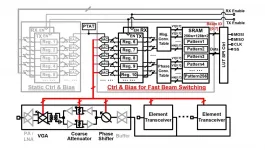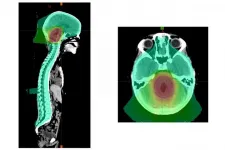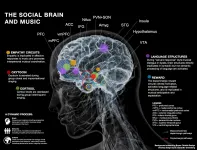(Press-News.org) Astronomers have spotted a giant 'blinking' star towards the centre of the Milky Way, more than 25,000 light years away.
An international team of astronomers observed the star, VVV-WIT-08, decreasing in brightness by a factor of 30, so that it nearly disappeared from the sky. While many stars change in brightness because they pulsate or are eclipsed by another star in a binary system, it's exceptionally rare for a star to become fainter over a period of several months and then brighten again.
The researchers believe that VVV-WIT-08 may belong to a new class of 'blinking giant' binary star system, where a giant star ? 100 times larger than the Sun ? is eclipsed once every few decades by an as-yet unseen orbital companion. The companion, which may be another star or a planet, is surrounded by an opaque disc, which covers the giant star, causing it to disappear and reappear in the sky. The study is published in Monthly Notices of the Royal Astronomical Society.
The discovery was led by Dr Leigh Smith from Cambridge's Institute of Astronomy, working with scientists at the University of Edinburgh, the University of Hertfordshire, the University of Warsaw in Poland and Universidad Andres Bello in Chile.
"It's amazing that we just observed a dark, large and elongated object pass between us and the distant star and we can only speculate what its origin is," said co-author Dr Sergey Koposov from the University of Edinburgh.
Since the star is located in a dense region of the Milky Way, the researchers considered whether some unknown dark object could have simply drifted in front of the giant star by chance. However, simulations showed that there would have to be an implausibly large number of dark bodies floating around the Galaxy for this scenario to be likely.
One other star system of this sort has been known for a long time. The giant star Epsilon Aurigae is partly eclipsed by a huge disc of dust every 27 years, but only dims by about 50%. A second example, TYC 2505-672-1, was found a few years ago, and holds the current record for the eclipsing binary star system with the longest orbital period ? 69 years ? a record for which VVV-WIT-08 is currently a contender.
The UK-based team has also found two more of these peculiar giant stars in addition to VVV-WIT-08, suggesting that these may be a new class of 'blinking giant' stars for astronomers to investigate.
VVV-WIT-08 was found by the VISTA Variables in the Via Lactea survey (VVV), a project using the British-built VISTA telescope in Chile and operated by the European Southern Observatory, that has been observing the same one billion stars for nearly a decade to search for examples with varying brightness in the infrared part of the spectrum.
Project co-leader Professor Philip Lucas from the University of Hertfordshire said, "Occasionally we find variable stars that don't fit into any established category, which we call 'what-is-this?', or 'WIT' objects. We really don't know how these blinking giants came to be. It's exciting to see such discoveries from VVV after so many years planning and gathering the data."
While VVV-WIT-08 was discovered using VVV data, the dimming of the star was also observed by the Optical Gravitational Lensing Experiment (OGLE), a long-running observation campaign run by the University of Warsaw. OGLE makes more frequent observations, but closer to the visible part of the spectrum. These frequent observations were key for modelling VVV-WIT-08, and they showed that the giant star dimmed by the same amount in both the visible and infrared light.
There now appear to be around half a dozen potential known star systems of this type, containing giant stars and large opaque discs. "There are certainly more to be found, but the challenge now is in figuring out what the hidden companions are, and how they came to be surrounded by discs, despite orbiting so far from the giant star," said Smith. "In doing so, we might learn something new about how these kinds of systems evolve."
INFORMATION:
Oncotarget published "The presence of polymorphisms in genes controlling neurotransmitter metabolism and disease prognosis in patients with prostate cancer: a possible link with schizophrenia" reported that polymorphisms of neurotransmitter metabolism genes were studied in patients with prostate cancer (PC) characterized by either reduced or extended serum prostate-specific antigen doubling time corresponding to unfavorable and favorable disease prognosis respectively.
The following gene polymorphisms known to be associated with neuropsychiatric disorders were investigated:
A. The STin2 VNTR in the serotonin transporter SLC6A4 gene;
B. The 30-bp VNTR in the monoamine oxidase A MAOA gene;
C. The Val158Met polymorphism in the catechol-ortho-methyltransferase ...
Scientists at Tokyo Institute of Technology (Tokyo Tech) and NEC Corporation jointly develop a 28-GHz phased-array transceiver that supports efficient and reliable 5G communications. The proposed transceiver outperforms previous designs in various regards by adapting fast beam switching and leakage cancellation mechanism.
With the recent emergence of innovative technologies, such as the Internet of Things, smart cities, autonomous vehicles, and smart mobility, our world is on the brink of a new age. This stimulates the use of millimeter-wave bands, which have far more signal bandwidth, to accommodate these new ideas. 5G can offer data ...
Medulloblastoma is a rare but devastating childhood brain cancer. This cancer can spread through the spinal fluid and be deposited elsewhere in the brain or spine. Radiation therapy to the whole brain and spine followed by an extra radiation dose to the back of the brain prevents this spread and has been the standard of care. However, the radiation used to treat such tumors takes a toll on the brain, damaging cognitive function, especially in younger patients whose brains are just beginning to develop.
A national study led by Washington University School of Medicine in St. Louis and St. Jude Children's Research Hospital suggests that children with what is called "average risk medulloblastoma" can receive a radiation "boost" to a smaller ...
Metformin is a widely prescribed blood sugar-lowering drug. It is often used as an early therapy (in combination with diet and lifestyle changes) for type 2 diabetes, which afflicts more than 34 million Americans.
Metformin works by lowering glucose production in the liver, reducing blood sugar levels that, in turn, improve the body's response to insulin. But scientists have also noted that metformin possesses anti-inflammatory properties, though the basis for this activity was not known.
In a study published online June 8, 2021 in the journal END ...
Married men who don't help out around the house tend to bring home bigger paychecks than husbands who play a bigger role on the domestic chores front.
New research from the University of Notre Dame shows that "disagreeable" men in opposite-sex marriages are less helpful with domestic work, allowing them to devote greater resources to their jobs, which results in higher pay.
In contemporary psychology, "agreeableness" is one of the "Big Five" dimensions used to describe human personality. It generally refers to someone who is warm, sympathetic, kind and cooperative. Disagreeable people do not tend to exhibit these characteristics, and they tend to ...
An estimated 8 million tons of plastic trash enters the ocean each year, and most of it is battered by sun and waves into microplastics--tiny flecks that can ride currents hundreds or thousands of miles from their point of entry.
The debris can harm sea life and marine ecosystems, and it's extremely difficult to track and clean up.
Now, University of Michigan researchers have developed a new way to spot ocean microplastics across the globe and track them over time, providing a day-by-day timeline of where they enter the water, how they move and where they tend to collect.
The approach relies on ...
Have you ever been cut off in traffic by another driver, leaving you still seething miles later? Or been interrupted by a colleague in a meeting, and found yourself replaying the event in your head even after you've left work for the day? Minor rude events like this happen frequently, and you may be surprised by the magnitude of the effects they have on our decision-making and functioning. In fact, recent research co-authored by management professor Trevor Foulk at the University of Maryland's Robert H. Smith School of Business suggests that in certain situations, incidental rudeness like this can be deadly.
In "Trapped ...
HOUSTON - (June 10, 2021) - Leaders who encourage their employees to learn on the job and speak up with ideas and suggestions for change have teams that are more effective and resilient in the face of unexpected situations, according to new research from Rice University and the University of Windsor.
"A Resource Model of Team Resilience Capacity and Learning" will appear in a special issue of Group & Organization Management. Authors Kyle Brykman, an assistant professor at the Odette School of Business at the University of Windsor, and Danielle King, an ...
Music is a tool that has accompanied our evolutionary journey and provided a sense of comfort and social connection for millennia. New research published today in the American Psychologist provides a neuroscientific understanding of the social connection with a new map of the brain when playing music.
A team of social neuroscientists from Bar-Ilan University and the University of Chicago introduced a model of the brain that sheds light on the social functions and brain mechanisms that underlie the musical adaptations used for human connection. The model is unique because it focuses on what happens in the brain when people make music together, rather than when they listen to music individually.
The research was inspired by creative efforts of people around the world to reproduce ...
Chestnut Hill, Mass. (6/10/2021) - A British man who rejected the standard of care to treat his brain cancer has lived with the typically fatal glioblastoma tumor growing very slowly after adopting a ketogenic diet, providing a case study that researchers say reflects the benefits of using the body's own metabolism to fight this particularly aggressive cancer instead of chemo and radiation therapy.
Published recently in the journal Frontiers in Nutrition, the report is the first evaluation of the use of ketogenic metabolic therapy (KMT) without chemo or radiation interventions, on a patient diagnosed with IDH1-mutant glioblastoma (GBM). Ketogenic therapy is a non-toxic nutritional approach, viewed as complementary or ...




